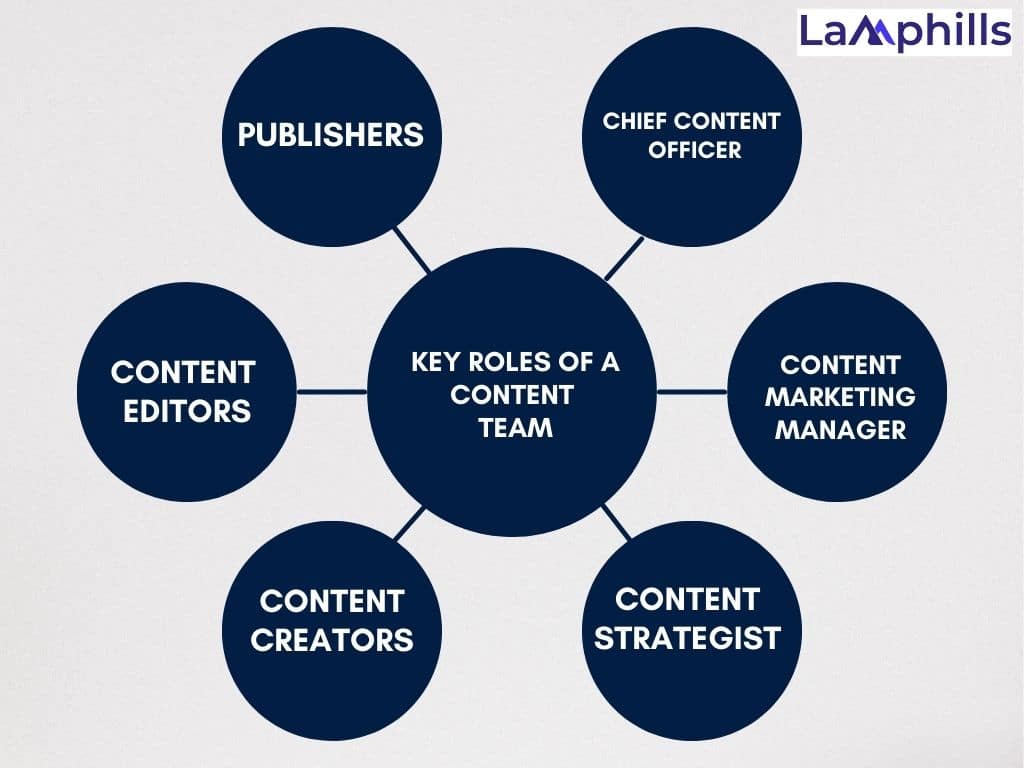Over the years, I’ve had the privilege of managing content team(s) for various blogs and firms. This role often required me to build and lead content teams that significantly boosted the SEO performance of these platforms.
From these experiences, I’ve gathered a handful of practical tips that I’m excited to share with you. These strategies are simple, tried and tested, and designed to truly make a difference. Let’s find out how you can reproduce this success in your projects.
To step up your content and help you build a content team marketing efforts, one of the things you should focus on is improving the structure of your content team. And how can you achieve this?
Firstly, I want you to note that no two content marketing teams look the same. Some have dozens of writers and editors, while others only have one writer and an editor/publisher/outreach specialist. Some have a team of technical SEO specialists, while others rely on a single web developer to do back-end SEO.
Read Also: CONTENT MARKETING: A User-Guide to Developing Your Business
In this article, I will explain everything you need to know about how to build and grow an effective Content Team. You‘ll learn:
- What a content team is
- The role of a content team
- What is the function of key roles in the content team
- Who makes up a content team
- How to structure your content team
- How to grow an effective content team
- How to build a content team from scratch
Let’s get started!
Key Points
1. A content team handles every aspect of content marketing for your business, it includes, formulating content ideas, creating actual content, optimizing, and distributing content.
2. The key roles in a Content Team include the Chief Content Officer (CCO), Content Marketing Manager, Content Strategist, Content Creators, Content Editor, Publishers, Social Media Experts, Technical Experts, and Outreach Specialists. Each role has specific responsibilities that contribute to the overall success of the content team.
3. To build a content team, start by creating a content strategy that aligns with business goals. Gradually build your team based on available resources, employing individuals with complementary skills.
4. When hiring team members, focus on employing quality writers, give clear job descriptions, and keep core roles like editors and SEO strategists in-house.
5. Use data to make informed decisions, stay flexible to adapt to changes in the online landscape, and invest in ongoing learning and development for your team to enhance content marketing efforts and achieve business objectives.
What is a Content Team?
A content team handles every aspect of content marketing for your business, this includes, formulating content ideas, creating actual content, optimizing, and distributing content.
This means your content team needs to develop a content strategy, create exceptional and high-quality content, pay attention to the details and technicalities in creating SEO content, and be creative in how they share and promote content.
Some companies choose to have their entire content team in-house, while many wish to save money by employing an in-house strategist and outsourcing the rest.
The success of your content marketing depends heavily on having an effective content team, regardless of the size of your company, whether small business, agency, or large brand. This brings us to the major roles every content team must possess.
Key Roles of a Content Team and their Functions.

There are a few positions you should consider employing when building a content team. In smaller companies, one person may be able to handle several of these jobs, but larger organizations usually have at least one person handling each of these roles. These roles include:
#1. The Chief Content Officer:
The chief content officer (CCO) is the top leader, he is the person responsible for managing all of the company’s content marketing. He handles everything from planning and budgeting to editing, publishing, and promoting content.
The CCO’s main task is to identify the department’s goals, big and small, and then decide how to use their resources, money, and talent, to reach these goals.
Depending on the company’s size, the Chief Content Officer (CCO) might not work directly with content or its creators. Instead, they typically coordinate with directors and managers who directly handle content production and marketing materials.
As a key executive, the CCO often connects its department with the rest of the company. For example, they might represent the content team in budget meetings or discuss content strategies with stakeholders for the next quarter.
#2. Content Marketing Manager:
A content marketing manager acts like the editor-in-chief of a newspaper. They run the daily activities of a company’s marketing team, guide content creators, and oversee marketing efforts. Based on plans from the team’s strategists, the manager sets up an editorial calendar that includes:
- The content to be created
- The creators assigned to each task
- Deadlines for each project
- Both small and large goals for each content piece
It is also the role of the content marketing manager to edit content to ensure it meets the department’s quality standards and follows the style guide. Regarding style guides, the content marketing manager often creates and updates these as needed.
Additionally, the content marketing manager tracks how well each content performs based on metrics, like keyword rankings, and regularly reviews published content to identify new opportunities.
Some companies have multiple content managers, each responsible for different clients or campaigns. In others, there’s just one manager who might also take on the role of the chief content officer, especially in companies without a specific content department, where the content team is part of the broader marketing team.
#3. The Content Strategist:
It is the responsibility of the content strategist to outline the team’s plan, this includes, deciding what content to create, its format, and where to publish it. This role involves analyzing various data to shape content strategies, including:
- Audience data: What does the audience want to read?
- Market data: What content is currently missing?
- Competitor data: What are competitors doing right or wrong?
- Current performance data: What’s working or failing for their company or client?
A content strategist is necessary for SEO, recognizing opportunities to rank well in search engine results (SERPs). Choosing the right keywords helps attract the right customers and boost brand visibility.
The content strategist communicates their plan to the content creators or the content marketing manager, who then guides the creators with this strategy.
#4. Content Creators:
The foundation of any content marketing strategy is its creators. They create the content that your audience sees, including the text, pictures, and videos. Depending on your plan, the members of your content production team might include:
- Bloggers/copywriters
- Photographers
- Graphic designers
- Podcasters
- Illustrators
- Video producers
And other creative professionals who create content following the guidance of the Chief Content Officer, marketing manager, and strategist.
Some companies have their own team of content creators, while others prefer to hire external contractors.
#5. Content Editor:
It is the role of the Content Editors to review every piece of content before it’s published to ensure it meets the following 3 basic requirements: maintain the company’s quality standards, it’s free of errors, and it’s consistent with the brand’s voice
The editing process varies by medium. For blogs, this means checking for spelling and grammar, improving structure for better readability, and using the right words to make ideas clear. It may also include using specific keywords to boost SEO.
For podcasts, editing involves adjusting audio tracks, combining recordings, and removing any silent parts. Regardless of the medium, every content editor wants to make sure that the content appropriately represents the brand.
#6. Publishers:
Publishers make sure people can see the content. Once the content is reviewed and approved, the publisher posts it on platforms like WordPress, Shopify, YouTube, or Apple Music.
During this process, the publisher can modify meta tags, like the title and description in the content management system to help viewers and search engines understand what the content is about.
For blog posts, publishers also include links within the article to improve its visibility on search engines. They add descriptions to images too, helping visually challenged individuals to understand what the images show.
#7. Social Media Experts
The role of the Social media experts in a content team is to promote the content. Creating content is hard work, so it’s important to make sure it is seen.
These team members might also create quick, engaging posts like holiday greetings or promotions on platforms like Facebook, Twitter, and Instagram.
A skilled social media expert can track how well posts are doing by looking at clicks and other interactions. This helps them figure out which content clicks with the audience and which doesn’t.
In smaller companies, these experts often handle online comments and complaints. In larger firms, while customer service usually deals with this, the content team might step in to help with responses during a public relations challenge.
#8. Technical Experts:
Tech skills are very necessary in digital marketing because our work depends on technology. If your WordPress site goes down, it won’t matter how great your content is, no one will be able to read it.
Technical experts are important for any content team, as they keep computers, websites, and software running smoothly.
Big companies often have a separate department for Tech Experts, while smaller firms make use of web development teams for technical support.
If you don’t have a technical expert or a freelancer ready to fix issues quickly, I will advise you to find one right away.
#9. Outreach Specialists:
The role of an outreach specialist in a content team is very important. This is because not everything your team writes is meant for your website or social media. Often, your content might be featured as a guest post on other sites or in online magazines.
This approach is great for your business as it builds your brand’s credibility and introduces you to new audiences. Plus, it helps with SEO since it can lead to valuable backlinks.
They find and secure places to publish your content. They manage the entire process, from searching for possible places to managing relationships and communications with publishers.
From evaluating possible places to managing relationships with publishers, they oversee the entire process.
How to Structure Your Content Team
In addition to the key content roles, here are some additional tips to consider when building and managing your content team:
#1. Create your Content Strategy:
This is the first step to structure your content team. I will advise you to develop your content strategy before hiring the team members.
A content strategy is the foundation of the team. It includes planning, creation, publication, management, and governance of content. A good content strategy will attract and engage a target audience, meeting their needs while driving business goals. That‘s if your business goals include increasing brand awareness
In setting out the content strategy, you clearly define job roles for each member of the team, before you can start hiring people to join the team. This makes it easier to employ the right people for each role.
#2. Build your team:
I will advise structuring your content team gradually, based on your resources. You can start freelance writers and an in-house editor, which is the foundation of a content team.
#3. Employ people with complementary skills:
According to Jonathan Aufray of Growth Hackers Agency, to structure a high-performing content team, you want to hire people with complementary skills,” says.
Take for example, instead of employing 4 blog content writers, you can employ a blog writer, an email copywriter, a video creator, and a visual creator. By having complementary skills, you will be able to work on different aspects of your marketing at the same time.
#4. Keep the lines of communication open:
I will advise you never to neglect small talk with your team. Always have regular meetings and check in with your team. It will help you identify your team’s main strengths and interests, and how each member could perform when given specific responsibilities. It also promotes partnerships, performing analysis, experimenting with new formats, running webinars, conducting deep research, and many more.
#5. Create exceptional content production systems and processes
In my experience, I have found that it’s best to have great SEOs do keyword research, great writers craft content, great editors improve each piece, etc. It all comes down to effective processes.
#6. Hold each team member accountable:
It is important to develop a team with responsible members. Make sure you share responsibility with every team member for each of the basic tasks, such as ideation, writing, reviewing, publishing, and distribution. It does not necessarily imply that they have to be the ones to do all the work, but they should know it’s their responsibility to see that the work is done. This encourages clarity and helps the work progress smoothly.
#7. Invest in exceptional writing
Focus on employing quality writers on the team. A few skilled writers who need little editing and training can save more time than a bigger team of less careful writers.
#8. Ensure the whole team understands and agrees with your objectives:
In my experience, it’s important to have a main content team that understands the company’s strategy and goals. People who know your business and can generate great ideas to push the company forward are key.
#9. Keep your editors in-house:
According to Danny Grainger, “A high-performing, cost-effective content team should be structured with an in-house editor, an in-house SEO strategist, then freelance remote writers” This structure ensures consistency in brand tone and voice because the same editor reviews everything. It also makes sure our content is good for SEO and can keep performing well over time.
#10. Write clear job descriptions for content team roles:
According to Ramesh Hassan from InvoZone, “A clear hierarchy where everyone knows their roles well is key to a successful content team.” Employing writers who have experience in journalism can be very beneficial. Their skills in research, critical thinking, and diverse writing styles help create creative and comprehensive content.
This will help you find the best people for each role.
Now that you know the basics of building and managing a content team, let’s walk through how to do it, step by step.
How to Build a Content Team
Create your Content Team using these simple steps:
#1. Create a strategy:
This includes:
- Define your goal.
- Choose your audience.
- Audit your content.
- Create a content marketing system.
- Create content ideas.
- Decide how you want to present that content. Will it be podcasts, text, videos, or infographics?
#2. Choose a managing editor:
Key qualities to look for in a Managing Editor:
- Attention to detail: They’re your final check before content goes live. Missed errors can embarrass your company when visitors spot them.
- Organization skills: They need to handle multiple tasks and deal with challenges like late submissions or inferior content effectively.
- Writing ability: It’s important that they can improve what writers produce, improving the content instead of destroying its quality.
#3. Start employing the other members of the team:
With your managing editor, start searching for a designer, marketing strategist, and writer. Although you might feel the urge to hire quickly, it’s wiser to start with freelancers on a project basis. This will let you know if they truly match your team’s needs and can deliver on their promises.
#4. Carefully look for writers:
There are many writers available, but not all are great. To find the best ones, you need to keep looking and trying out new writers, whether you find them individually online or through writing services.
Your main goal should be to find writers whose style matches what you need. They don’t need to be experts in your specific area right away. With lots of information online, they can quickly learn what they need to know.
#5. Set up a clear system for promotions and rewards:
The best talent is eager to learn new skills and find new jobs, so companies must have an official recognition system in place. To reward talented people, you can offer them full-time positions, provide skill development through workshops, classes, and courses, promote them to better positions, and publicly and privately praise their abilities.
#6. Grow progressively:
A successful content marketing team should avoid rushing things, as this may not establish a strong foundation and may lead to unintended consequences.
To enhance your content marketing strategy, carefully consider and weigh each step before moving on. This may require slow progress, so it’s advisable to retain your previous marketing methods to make sure your plans are effectively carried out.
Conclusion.
In conclusion, building a strong content team is necessary for succeeding online. Start by bringing together different team members. Make sure your content strategy aligns with your business goals and keeps your audience engaged with meaningful content.
Use data to make smart choices and stay flexible to keep up with online changes. Investing in your team’s growth and encouraging ongoing learning will help your content reach and impact your audience. This approach will boost your brand’s online visibility and growth.
By adopting the principles in this article, you won’t just be managing content; you will be crafting experiences, building relationships, and driving growth.
Thank you for reading. Hope you found this article helpful. Please like, subscribe, and share for more educating write-ups.
Frequently Asked Questions
What is a content role?
A content role is a position where you develop content for a business that helps them connect with their clients.
What is Content marketing?
Content marketing is a strategy where you create and share online content such as videos, blogs, and social media posts. This content doesn’t directly advertise a brand but aims to stimulate interest in its products or services.
What does a content strategy team do?
The main duty of a content strategist is to plan content. This involves creating, organizing, and researching content. As a strategist, your job is to think of creative ways to engage online audiences and create content that captures their interest.
Who makes up a content team?
A good team needs five content creators, a senior editor, a junior developer for publishing and tech support, an SEO specialist for keyword research and performance checks, and a content manager to oversee everything and keep ideas fresh.
What is the main purpose of content?
The main purposes of content is to educate, entertain, inspire, and convince.
What is the difference between content and creative team?
Creative writing is usually meant to express feelings, entertain, or captivate readers. Sometimes, writers just write randomly without any specific reason. Content writing, on the other hand, always has a clear goal, such as marketing, increasing sales, sharing information, or other business-related aims.
Related Articles:
Monitoring Online Content: How To Do This In 5 Steps





